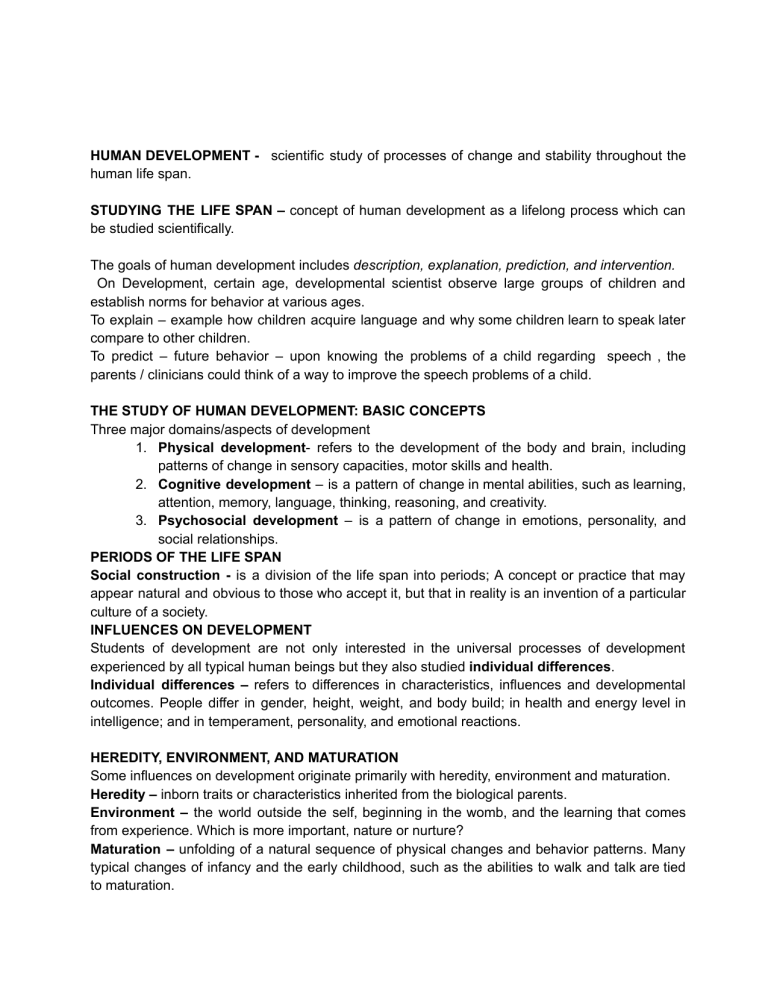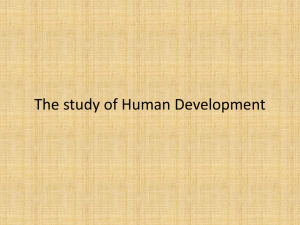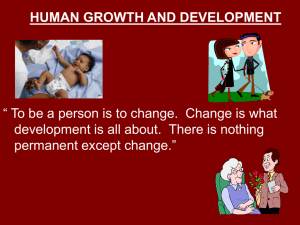
HUMAN DEVELOPMENT - scientific study of processes of change and stability throughout the human life span. STUDYING THE LIFE SPAN – concept of human development as a lifelong process which can be studied scientifically. The goals of human development includes description, explanation, prediction, and intervention. On Development, certain age, developmental scientist observe large groups of children and establish norms for behavior at various ages. To explain – example how children acquire language and why some children learn to speak later compare to other children. To predict – future behavior – upon knowing the problems of a child regarding speech , the parents / clinicians could think of a way to improve the speech problems of a child. THE STUDY OF HUMAN DEVELOPMENT: BASIC CONCEPTS Three major domains/aspects of development 1. Physical development- refers to the development of the body and brain, including patterns of change in sensory capacities, motor skills and health. 2. Cognitive development – is a pattern of change in mental abilities, such as learning, attention, memory, language, thinking, reasoning, and creativity. 3. Psychosocial development – is a pattern of change in emotions, personality, and social relationships. PERIODS OF THE LIFE SPAN Social construction - is a division of the life span into periods; A concept or practice that may appear natural and obvious to those who accept it, but that in reality is an invention of a particular culture of a society. INFLUENCES ON DEVELOPMENT Students of development are not only interested in the universal processes of development experienced by all typical human beings but they also studied individual differences. Individual differences – refers to differences in characteristics, influences and developmental outcomes. People differ in gender, height, weight, and body build; in health and energy level in intelligence; and in temperament, personality, and emotional reactions. HEREDITY, ENVIRONMENT, AND MATURATION Some influences on development originate primarily with heredity, environment and maturation. Heredity – inborn traits or characteristics inherited from the biological parents. Environment – the world outside the self, beginning in the womb, and the learning that comes from experience. Which is more important, nature or nurture? Maturation – unfolding of a natural sequence of physical changes and behavior patterns. Many typical changes of infancy and the early childhood, such as the abilities to walk and talk are tied to maturation. There is a need to consider the inherited characteristics that give each person a start in life to further recognize development. CONTEXT OF DEVELOPMENT Human beings are social beings. Since the start individual progress through social and historical setting. 1. FAMILY. The direct link of a baby is usually the family. Types of Family. A. Nuclear family – is a family consists of one or two parents and their children which could be biological, adopted, or stepchildren. B. Extended family – a multigenerational network of grandparents, aunts, uncles, cousins, and more distant relatives is the traditional form. 2. SOCIOECONOMIC STATUS and NEIGHBORHOOD. Socioeconomic status (SES) is a combination of economic and social factors describing an individual or family, including income, education, and occupation. It is grounded on family income and the educational and occupational levels of the adults in the household. 3. CULTURE and RACE/ETHNICITY Culture refers to a society’s or group’s total way of life, including its customs, traditions, laws, knowledge, beliefs, values, language, and physical products, from tools to artworks -all of the behavior and attitudes that are learned, shared, and transmitted among members of a social group. Ethnic group – consists of people united by a distinctive culture, ancestry, religion, Language, or national origin, all of which contribute to a sense of shared identity and shared attitudes, beliefs, and values. 4. THE HISTORICAL CONTEXT. Historical context – is the time in which people live. NORMATIVE AND NONNORMATIVE INFLUENCES Normative – characteristic of an event that occurs in a similar way for most people in a group. Two types of normative influences- biological or environmental events that affect many or most people in a society in similar ways and events that touch only certain individuals. 1. Normative age-graded influences- are highly similar people in a particular age group. The timing of biological events is fairly predictable within a normal range. 2. Normative history-graded influences are significant events that shape the behavior and attitudes of a historical generations. Historical generations- a group of people strongly influenced by a major historical event during their formative period. A historical generation is not the same as an age cohort. Cohort – group of people born at about the same time. Nonnormative influences are unusual events that have a major impact on individual lives because they disturb the expected sequence of life cycle. TIMING OF INFLUENCES: CRITICAL OR SENSITIVE PERIODS. Imprinting – instinctive form of learning in which, during a critical periods in early development, a young animal forms an attachment to the first moving objects it sees, usually the mother. Critical Period- specific time when given event or its absence has a specific impact on development. Plasticity - Range or modification of performance Modifiability or molding of the brain through experience. Sensitive periods – times in development when a person is particularly open to certain kinds of experiences. THE LIFE-SPAN DEVELOPMENTAL APPROACH 1. Development is lifelong 2. Development is multidimensional 3. Development is multidirectional. 4. Relative influences of biology and culture shift over the life span. 5. Development involves changing resource allocations. 6. Development shows plasticity 7. Development is influenced by the historical and cultural context. DEVELOPMENTAL PSYCH (PRELIM) INTRODUCTION: Human Development: • Developmental Psychology is the branch of psych that studies intra-individual changes and inter-individual changes within this intra-individual changes. • 6 MAJOR OBJECTIVES OF DEV PSYCH 1. to find out what are the common and characteristics, age changes and appearance, behavior, goals, interest from one developmental period to another 2. to find out when these changes occur 3. to find out what causes them 4. to find out how they influence behavior 5. to find out whether it can or cannot be predicted 6. to find out whether they are individual and universal DEVELOPMENTAL CHANGE: • development: progressive series of changes that occur as a result of maturation and experience/learning • acc to van it implies qualitative changes (development is a complex progress of integrating many functions and structures) Development: implies qualitative changes Growth: implies quantitative changes


